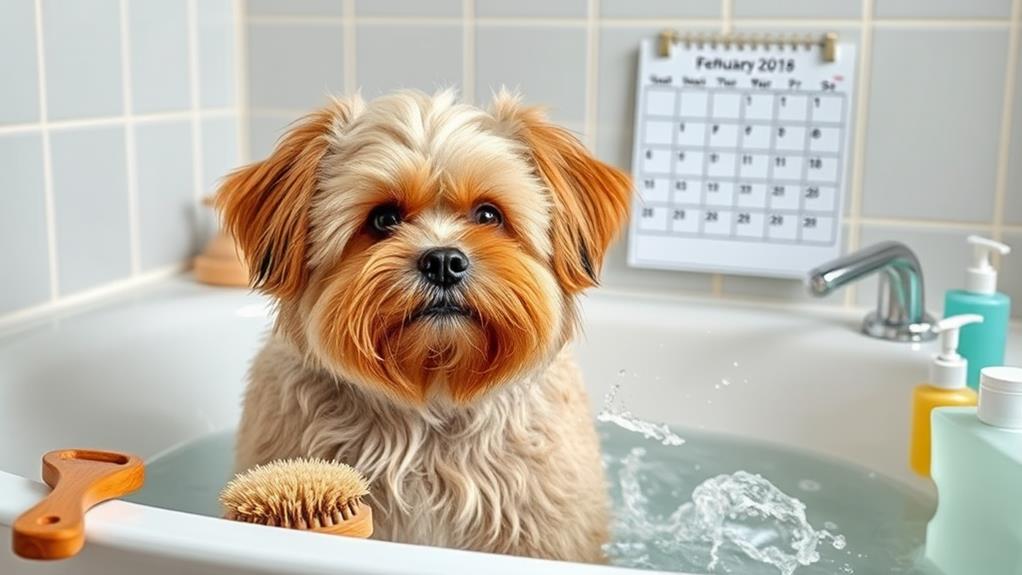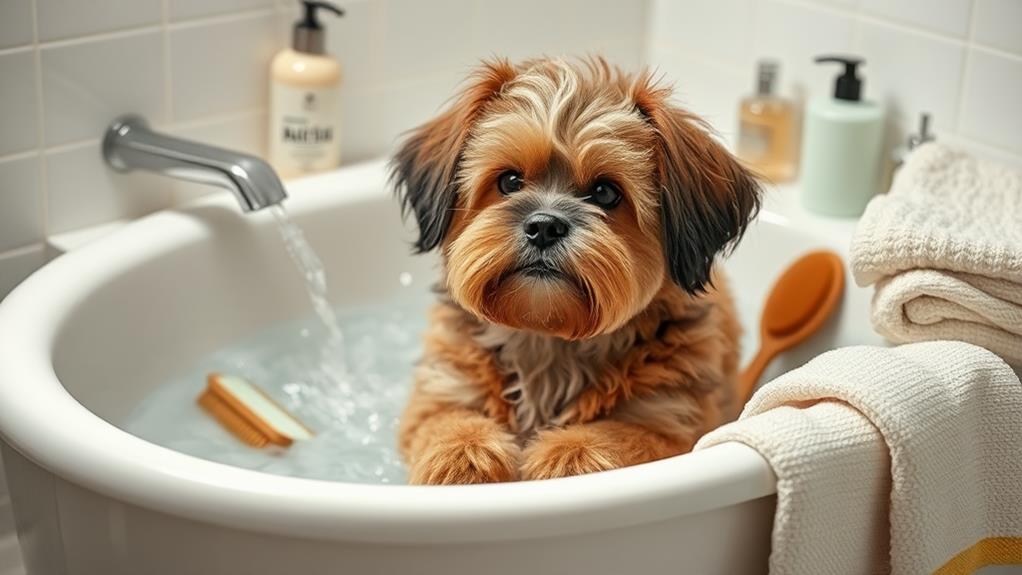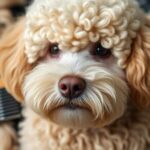To effectively bathe and groom your double-coated dog, start by gathering the right tools like a slicker brush, undercoat rake, and a gentle shampoo. Before bathing, brush out loose fur to prevent matting. Use lukewarm water and a handheld showerhead to wet your dog, ensuring you apply shampoo to both the topcoat and undercoat, rinsing thoroughly. After bathing, use towels or a high-velocity dryer to dry them off. Finally, brush regularly to keep the coat healthy and tackle seasonal shedding. There's plenty more to explore about grooming techniques and tips to keep your pup looking great!
Understanding Double-Coated Breeds

Double-coated breeds have a unique coat structure that consists of two layers: a dense undercoat and a longer topcoat. This combination serves various purposes, like insulation and protection from the elements. The undercoat traps warmth in cold weather, while the topcoat repels moisture and dirt. Understanding this structure is vital for effective grooming and bathing.
You might notice that your double-coated dog sheds more during seasonal changes. That's because the undercoat goes through a shedding cycle, often referred to as "blowing coat." This process can be more pronounced in spring and fall, making regular grooming essential to manage the shedding and keep your home fur-free.
When you groom your dog, you'll want to pay close attention to both layers. The undercoat can become matted if not treated properly, leading to discomfort for your pet. Additionally, double-coated breeds often have specific bathing needs; over-bathing can strip the natural oils in their coats, leading to skin issues. Familiarizing yourself with these characteristics will help maintain your dog's coat healthy and vibrant, enhancing their overall well-being.
Essential Grooming Tools

Having the right grooming tools is essential for keeping your double-coated dog healthy and comfortable. Start with a slicker brush; its fine, bent wires effectively remove loose fur and prevent matting. You'll also want an undercoat rake, which helps reach deeper into the dense undercoat to eliminate dead hair. Regular use of these tools can drastically reduce shedding.
A de-shedding tool, like the Furminator, can be a game changer as it specifically targets the undercoat without damaging the top coat. Don't forget a quality comb; a wide-toothed comb is great for detangling while a finer comb can help with finishing touches.
You should have nail clippers or a grinder handy for keeping your dog's nails at a manageable length, along with a dog-safe shampoo for those bath times. In conclusion, consider investing in a good quality grooming table with a non-slip surface and harness to keep your dog secure during grooming sessions.
Preparing for Bathing

Before you turn on the water, gather everything you need for a smooth bathing experience. Preparation is key to making bath time less stressful for both you and your double-coated dog. Here's a quick checklist to guarantee you're ready:
- Dog Shampoo: Choose a gentle, double-coated dog shampoo that suits your dog's skin type. Avoid human shampoos, as they can irritate their skin.
- Brush: Have a slicker brush or deshedding tool handy to remove loose fur and prevent mats before bathing.
- Towels: Gather a few absorbent towels for drying your dog afterward. A microfiber towel works great for soaking up water quickly.
- Non-Slip Mat: Place a non-slip mat in the tub or bathing area to prevent your dog from slipping while they're wet.
With these essentials in place, you'll create a more efficient and enjoyable bathing experience for your furry friend. Taking the time to prepare not only makes the process smoother but also helps your dog feel more comfortable and relaxed during their bath.
Bathing Techniques

With everything prepared, it's time to get your dog into the bathing area. Start by gently guiding your dog into the tub or shower. Maintain the water temperature is lukewarm; dogs can be sensitive to extreme temperatures. Use a handheld showerhead or a cup to wet your dog's coat thoroughly, starting from the neck and moving down to the tail. Avoid spraying directly in their face to prevent discomfort.
Once your dog is wet, apply a quality dog shampoo specifically designed for double-coated breeds. Work the shampoo into the outer coat, then reach the undercoat using your fingers to guarantee a deep clean. Massage the shampoo in circular motions, paying special attention to areas prone to dirt, like the paws and belly.
After a few minutes, rinse thoroughly, maintaining no shampoo residue remains. You might need to rinse multiple times, especially in the undercoat. If your dog tolerates it, use a dog conditioner to help with tangles and dryness. Apply it similarly, then rinse again. Keeping the bathing process calm and positive will help your dog feel more comfortable and cooperative throughout the experience.
Drying Methods

Once your dog is clean, it's time to focus on drying them off properly. A double-coated dog retains moisture, so using the right drying methods is crucial.
- Towel Drying: Begin by using an absorbent towel. Gently squeeze and rub your dog's fur to remove excess water. Avoid vigorous rubbing, as it can tangle their coat.
- Air Drying: If the weather permits, let your dog air dry in a warm, sheltered area. Keep a close eye on them to guarantee they don't get too cold or wander off.
- High-Velocity Dryer: For quicker results, consider a high-velocity pet dryer. This tool blows warm air through the coat, helping to dry them efficiently without causing damage.
- Fleece Drying Coat: Invest in a fleece drying coat specifically designed for dogs. These coats absorb moisture and help keep your pup warm while they dry.
Brushing and De-shedding

After your dog is fully dry, it's time to tackle brushing and de-shedding. This step is essential for maintaining your dog's coat and minimizing shedding around your home. Start by choosing the right tools. A slicker brush works wonders for removing loose hair and tangles, while an undercoat rake is perfect for reaching the dense undercoat typical of double-coated breeds.
Begin brushing at the back and work your way toward the front, using gentle, even strokes. Be thorough but patient, especially in areas where mats tend to form, like behind the ears and under the legs. If you encounter any tangles, use your fingers to gently work them out before continuing with the brush.
For de-shedding, use a de-shedding tool specifically designed for double-coated dogs. This tool helps remove the loose undercoat without damaging the topcoat. Focus on areas like the belly and thighs, where shedding often occurs. Aim to brush your dog at least once a week, or more frequently during seasonal shedding periods. Regular brushing keeps your dog's coat healthy and reduces the amount of hair you find around your home.
Ear and Nail Care

Caring for your dog's ears and nails is just as important as grooming their coat. Regular maintenance helps prevent infections and discomfort.
Check Ears Weekly: Inspect your dog's ears for dirt, wax buildup, or redness. Use a vet-approved cleaner and cotton balls to gently wipe the outer ear. Avoid inserting anything deep into the ear canal.
Trim Nails Monthly: Keep your dog's nails trimmed to prevent pain or injury. If you hear clicking sounds on hard surfaces, it's time for a trim. Use dog nail clippers or a grinder, and be careful not to cut into the quick.
Reward Positivity: Make ear cleaning and nail trimming a positive experience by using treats and praise. This will help your dog associate these tasks with enjoyable moments.
Know When to Seek Help: If you notice any signs of infection, like swelling or a bad odor, consult your vet. They can provide professional cleaning or treatment if necessary.
Maintaining Coat Health

Maintaining your double-coated dog's coat health is essential for their overall well-being and comfort. A healthy coat not only looks good but also protects your dog from environmental elements. To safeguard your dog's coat remains in top condition, focus on nutrition, hydration, and regular brushing.
| Aspect | Tips | Benefits |
|---|---|---|
| Nutrition | Feed high-quality dog food rich in Omega-3 and Omega-6 fatty acids. | Promotes a shiny, soft coat. |
| Hydration | Ensure your dog has access to fresh water at all times. | Prevents dry skin and coat. |
| Brushing | Brush your dog several times a week to remove loose fur. | Reduces shedding and matting. |
| Bathing | Use a gentle dog shampoo, ideally every 6-8 weeks. | Keeps coat clean without stripping oils. |
| Check for Issues | Regularly inspect for parasites or skin irritations. | Early detection of health issues. |
Regular Grooming Schedule

Establishing a regular grooming schedule is vital for keeping your double-coated dog looking and feeling their best. Consistent grooming not only helps manage shedding but also prevents mats and promotes healthy skin.
- Brush Weekly: Aim to brush your dog at least once a week. This will help remove loose fur and reduce shedding around your home.
- Monthly Baths: Plan to bathe your dog every month. Use a gentle dog shampoo to maintain coat health without stripping natural oils.
- Seasonal Grooming: Increase grooming frequency during shedding seasons (spring and fall). You might need to brush them several times a week during these periods.
- Regular Checks: Make it a habit to check for mats, dirt, or skin issues during each grooming session. Early detection can prevent more serious problems later.
Frequently Asked Questions
How Often Should I Bathe My Double-Coated Dog?
You should bathe your double-coated dog every 4 to 6 weeks, depending on their activity level and environment. Regular brushing helps reduce the need for frequent baths, keeping their coat clean and healthy.
Can I Use Human Shampoo on My Dog?
Did you know that 60% of dog owners mistakenly use human shampoo? You shouldn't use it on your dog; it can disrupt their skin's pH balance. Stick to dog-specific shampoos for the best results.
What Signs Indicate My Dog Needs Grooming?
You'll notice your dog needs grooming when their coat looks matted, they shed excessively, or their skin appears flaky. If they're scratching more than usual or have an unpleasant odor, it's time for a grooming session.
Are There Specific Diets for Healthier Double-Coated Fur?
Yes, specific diets can enhance your double-coated dog's fur health. Focus on high-quality proteins, omega fatty acids, and antioxidants. These nutrients help maintain a shiny coat and reduce shedding, ensuring your pup looks its best.
How Can I Reduce Shedding Between Grooming Sessions?
Imagine a snowstorm in your living room—shedding can feel like that! To reduce it, brush your dog regularly, keep them hydrated, and feed them a balanced diet. These steps help minimize excess fur between grooming sessions.
Conclusion
By mastering the art of grooming your double-coated dog, you're not just keeping them clean; you're building a bond, much like a painter creating a masterpiece. Remember, regular grooming isn't just a chore; it's a chance to explore the depths of your dog's personality and health. So, embrace the process, and let your love for your furry friend shine through. With patience and care, you'll have a happy, healthy pup that's ready for any adventure!



